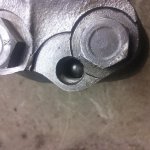tr3guy
Member
Offline
I hope this isn't a silly question, but, while in the process of restoring the breaking system, in my TR3A, TS 68710, I found what appeared to be a small ball bearing, a little larger than a BB stuck in the bottom of the brake fluid inlet hole on the right hand caliper. I can't imagine how it got there or why it should be there since it effectively blocks the flow of fluid into the caliper. I would be willing to entertain any reasonable explanation of why it should be there, but I think it should come out. I thought it could be removed easily with a magnet, but no luck. I have never had the brakes operational, and the body of the car is off the frame, in the body shop. I guess I could wait until everything is back together and try reversing the fluid back through the bleeder valve hole when the pistons are back in, but that could be several months down the road. Any thoughts on how to get it out???

 Hi Guest!
Hi Guest!

 smilie in place of the real @
smilie in place of the real @
 Pretty Please - add it to our Events forum(s) and add to the calendar! >>
Pretty Please - add it to our Events forum(s) and add to the calendar! >> 
